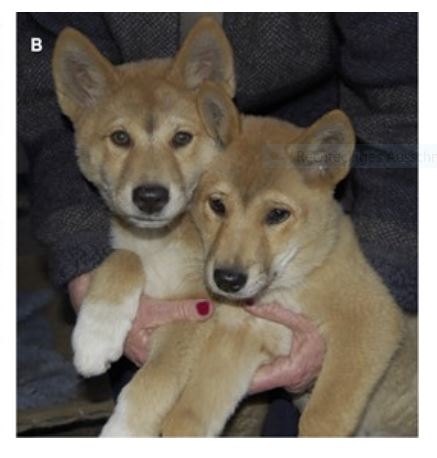Multi-dimensional data for Cooinda the dingo
A new GigaScience article presents rich multi-dimensional data for one Alpine dingo named Cooinda. The high-quality genome sequence, other molecular biology data, and magnetic resonance imaging of brain tissue will serve as a point of reference for exploring the evolutionary history of dingoes. The goal is to better understand how and when humans influenced the breed’s anatomy, genetics and behavior.
What exactly is a dingo? A dog? A wolf? Something in between? What we know: They came to Australia several thousand years ago. When they first arrived on the continent— probably in the company of sailors — they likely already had a history of interactions with humans that shaped their behavior, their anatomy and their genes.
Earlier work, including a whole genome sequence, has confirmed that dingoes are indeed an early offshoot of modern dog, between the wild wolf and today’s domesticated dogs. However, domestication is a long process, and maybe the dingo is indeed somewhat marking an intermediate stage of domestication. In that sense the breed is distinct from what we usually consider a dog (“Canis familiaris“) – and indeed, some scientists have proposed to give the dingo its own taxonomic name, setting it apart from the dog.
A reference point to study the dingo’s origin
What complicated the debate about the dingo’s origin so far was the absence of an example specimen that researchers could use as a reference point for detailed comparisons at all levels – including morphology, genetics and molecular biology.
That’s where the team led by Bill Ballard (University of Melbourne) and their new GigaScience paper come in: They propose one taxidermally prepared specimen, an alpine dingo named Cooinda, as the model specimen to represent a typical dingo that they call an “archetype”. This designated type specimen – and the data collected on it – will help to better understand the unique placement of the dingo between a wild and a fully domesticated species.

Charles Darwin was fascinated by domestication of animals, and in fact observations on domesticated animals were a departure point when laying out the theory of evolution ( he was particularly obsessed with pigeon breeds, as every reader of his “Origin of species” will soon realize).
Are dingoes tamed but not domesticated?
Darwin proposed a two-step model of domestication: According to this idea, the first step is characterized by “unconscious” selection, leading to merely tamed rather than domesticated animals; followed in a second step by what biologists today call artificial selection. The hallmark of the second stage is that humans deliberately interfere in mating and reproduction.
Is the Dingo an example of a population that only made it to the first step in Darwin’s model, but not the second? Maybe the dingo is not a “feralized” dog, but was never really selectively bred by humans in the first place.
Prof. Bill Ballard, first author of the new GigaScience study, explains: “Unfortunately, the absence of a dingo reference specimen impedes our ability to definitively determine whether dingoes are a tamed intermediate or a feral canid, because we do not have a single reference point that links the scientific name to a specific specimen.”

The genomic and morphological data in the new study is based upon an Alpine Dingo named Cooinda from Dingo Sanctuary Bargo in New South Wales, Australia. The previously published Dingo genome was based on another animal, Sandy, a Desert Dingo, and the new data also allow comparisons between the Alpine and Desert ecological types.
Dingoes come in two varieties: Alpine and desert
In addition to the high quality genome data, the Australian team also collected mitochondrial DNA sequences and DNA methylome data, and linked this molecular information with morphological analyses of head shape and magnetic resonance imaging of Cooinda’s brain.
Along with other morphological changes, “domesticated animals often show reduced brain size compared to their wild relatives” notes study co-author Assoc. Prof. Laura Wilson (ANU). The brain analyses show that Cooinda had a larger cranial capacity than a similar-sized domestic dog.
Having such a data-rich and diverse characterization of a single individual makes Cooinda an ideal candidate to be considered the “archetype” for Dingo. She is now on display at the Australia Museum in Sydney.
Further Reading:
Ballard JWO, Field MA, Edwards RJ, Wilson LAB, Koungoulos L, Rosen BD et al. The Australasian dingo archetype: De novo chromosome-length genome assembly, DNA methylome, and cranial morphology
GigaScience,2023, giad018 https://doi.org/10.1093/gigascience/giad018
Data Availability:
Ballard JWO, Field MA, Edwards RJ, Wilson LAB, Koungoulos L, Rosen BD et al. Supporting data for “The Australasian dingo archetype: De novo chromosome-length genome assembly, DNA methylome, and cranial morphology” GigaScience Database. 2023. http://dx.doi.org/10.5524/102356
MRI Alpine dingo and domestic dog brain. Figshare repository. 2022.
https://doi.org/10.6084/m9.figshare.20514693.v2
